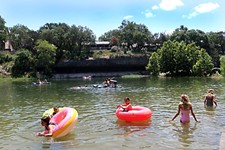Day Trips
The Waco Mammoth Site tells an amazing story of the prehistoric elephant's natural parenting instincts
By Gerald E. McLeod, Fri., Oct. 6, 2006

The Waco Mammoth Site tells an amazing story of the prehistoric elephant's natural parenting instincts. Although not currently open to the public, the site is being considered for inclusion into the National Park Service.
The archeology site is unique because it preserves a herd killed by natural causes, and it includes adults and juveniles, says Russ Whitlock, superintendent of the LBJ National Historic Park and state coordinator for NPS. "We can learn a lot about the period from the burial site," he says.
Two hikers discovered the fossilized remains of the elephantlike creatures sticking out of the river bank in 1976. The site is about a five-minute drive from downtown Waco near the confluence of the Brazos and Bosque rivers. The city and Baylor University have purchased 50 acres around the bones to protect the site.
Almost immediately after the discovery, scientists from Baylor's Strecker Museum began painstakingly uncovering the remains. The events of that fatal day 28,000 years ago that paleontologists have pieced together illustrates the sometimes-heart-wrenching realities of nature.
The Texas landscape the mammoths saw would have looked much different from the rolling hills of today. It was much drier and cooler. The inhospitable terrain was occupied by creatures like saber-toothed tigers, an early ancestor of the buffalo, and possibly roving bands of humans.
In the southern United States, herds of 20 to 50 Colombian mammoths traveled in family groups. Distant relatives of the hairier woolly mammoths, these American cousins ranged from Alaska to southern Mexico and looked more like modern elephants. The Colombian mammoth could weigh as much as 10 tons and stand 15 feet tall at the shoulders. Although they were herbivores, they had enormous tusks that grew up to 16 feet long.
It might have been an early spring day when the herd of Waco Colombian mammoths wandered to the water's edge of the Bosque River. The stream began rising slowly at first as a thunderstorm moved down the river valley. In a flash, the herd was trapped in flood waters. The rain turned the clay banks into a slippery muck.
In the confusion as the mammoths tried to escape, a 55-year-old bull and 45-year-old female each grabbed a juvenile in their mighty tusks and tried to lift the youngsters out of harm's way. As the pair struggled up the steep incline from the river followed by the rest of the family, the muddy bank collapsed and buried them all in an instant.
So far scientists have found the skeletons of 24 mammoths at the site along with a camellike animal. It is the largest concentration of the mammoth species ever found that died of natural causes, Whitlock says.
The NPS is working on a resource study for Congress that will determine a mission statement for the site as well as its significance and its suitability and feasibility as a national park. The report is due in late 2007. After that, members of Congress can introduce a bill that would add the site to the 400 NPS properties around the country, or the president could designate it a national site under the Antiquities Act. "At best it will be 10 years or more before it opens as a national park," Whitlock says.
Texas has 14 NPS units. They are Alibates Flint Quarries National Monument, Amistad National Recreation Area, Big Bend National Park, Big Thicket National Preserve, Chamizal National Memorial, El Camino Real de Tierra Adentro National Historic Trail, Fort Davis National Historic Site, Guadalupe Mountains National Park, Lake Meredith National Recreation Area, LBJ National Historical Park, Padre Island National Seashore, Palo Alto Battlefield National Historic Site, Rio Grande Wild and Scenic River, and the San Antonio Missions National Historical Park.
With a grant from Save America's Treasures, Baylor University has improved security at the site, built a semipermanent cover over the bones, and is exploring ways to allow the public limited access. You can see a partial casting of the bones at the Mayborn Museum, 1300 S. University, in Waco. The museum is open Monday through Saturday from 10am to 5pm and on Sunday from 1 to 5pm. Information on the museum is available at 254/710-1110 or www.baylor.edu/mayborn.
797th in a series. Day Trips, Vol. 2, a book of Day Trips 101-200, is available for $8.95, plus $3.05 for shipping, handling, and tax. Mail to: Day Trips, PO Box 33284, South Austin, TX 78704.








